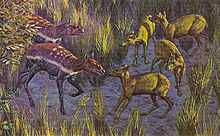Hypertragulus
| Hypertragulus Temporal range: Eocene–Miocene | |
|---|---|
| | |
| Scientific classification | |
| Kingdom: | Animalia |
| Phylum: | Chordata |
| Class: | Mammalia |
| Order: | Artiodactyla |
| Family: | Hypertragulidae |
| Genus: | Hypertragulus Cope, 1873 |
| Species | |
| |
 | |
| Range of Hypertragulus based on fossil record | |
Hypertragulus is an extinct genus belonging to the family Hypertragulidae, within the order Artiodactyla, endemic to North America during the Eocene to Miocene, living 42 to 20.6 million years ago, existing for approximately 21.4 million years.[1]
Hypertragulus were primitive and ancient ruminants, resembling small deer or musk deer, although they were more closely related to modern chevrotains. Its diet is stated to be that of a frugivore.
Morphology

Restoration of a Leptomeryx pair encountering a group of Hypertragulus
One specimen of Hypertragulus examined for body mass by M. Mendoza, C. M. Janis and P. Palmqvist had a mass of 7.29 kg (16 lb).[2]
Fossil distribution
A partial list of fossil sites:
- Chihuahua, Mexico
- Cedar Creek Formation (Lower & Middle), Logan County, Colorado
- Fort Logan Formation, Meagher County, Montana
- Upper Pomerado Conglomerate Formation, San Diego County, California
- Turtle Cove Member of the John Day Formation, Grant County, Oregon
References
- ↑ PaleoBiology Database: Hypertragulus, basic info
- ↑ M. Mendoza, C. M. Janis & P. Palmqvist (2006). "Estimating the body mass of extinct ungulates: a study on the use of multiple regression" (PDF). Journal of Zoology 270 (1): 90–101. doi:10.1111/j.1469-7998.2006.00094.x.